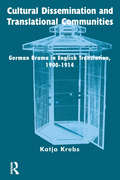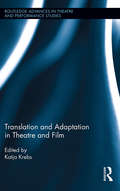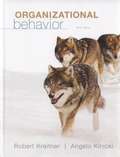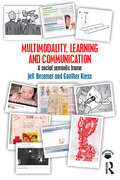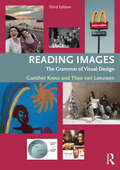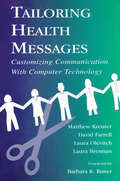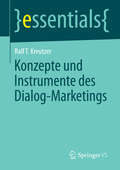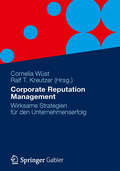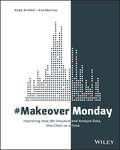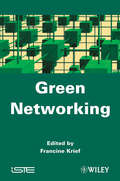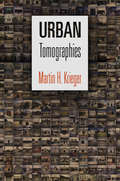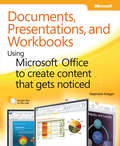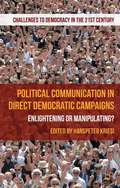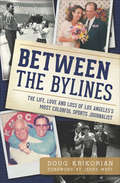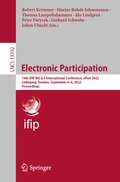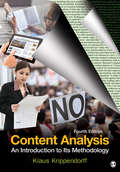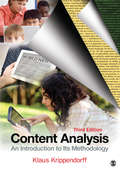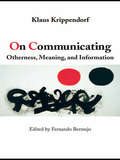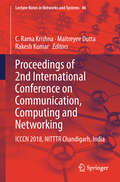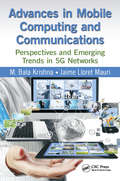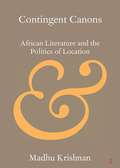- Table View
- List View
Bürgerbeteiligung richtig machen: Was die Ethik-Richtlinie ‚Bürgerbeteiligung und Kommunikation‘ für die Praxis bedeutet (essentials)
by Felix KrebberDieses essential bietet komprimiertes Wissen zur Kommunikationsethik informeller Bürgerbeteiligung. Erklärt wird, was Bürger*innen von Beteiligungsverfahren durch Unternehmen, Behörden und Agenturen erwarten, welche Formen es gibt und wo Defizite liegen. Kommunikationsethische Probleme werden anschaulich gemacht. Schwerpunkt des Bandes ist die detaillierte Beschreibung der Richtlinie ‚Bürgerbeteiligung und Kommunikation‘ des Deutschen Rates für Public Relations (DRPR) mit praktischen Tipps zur Einhaltung der Regeln in der Praxis.
Cultural Dissemination and Translational Communities: German Drama in English Translation 1900-1914
by Katja KrebsThe early twentieth century is widely regarded as a crucial period in British theatre history: it witnessed radical reform and change with regard to textual, conceptual and institutional practices and functions. Theatre practitioners and cultural innovators such as translators Harley Granville Barker, William Archer and Jacob Thomas Grein, amongst others, laid the foundations during this period for - what is now regarded to be - modern British theatre. In this groundbreaking work, Katja Krebs offers one of the first extended attempts to integrate translation history with theatre history by analyzing the relationship between translational practice and the development of domestic dramatic tradition. She examines the relationship between the multiple roles inhabited by these cultural and theatrical reformers - directors, playwrights, critics, actors and translators - and their positioning in a wider social and cultural context. Here, she takes into consideration the translators as members of an artistic network or community, the ideological and personal factors underlying translational choices, the contemporaneous evaluative framework within which this translational activity for the stage occurred, as well as the imprints of social and cultural traces within specific translated texts. Krebs employs the examples from this period in order to raise a series of wider issues on translating dramatic texts which are important to a variety of periods and cultures. Cultural Dissemination and Translational Communities demonstrates that an analysis of stage-translational practices allows for an understanding of theatre history that avoids being narrowly national and instead embraces an appreciation of cultural hybridity. The importance of translational activity in the construction of a domestic dramatic tradition is demonstrated within a framework of interdisciplinarity that enhances our understanding of theatrical, translational as well as cultural and social systems at the international level.
Translation and Adaptation in Theatre and Film (Routledge Advances in Theatre & Performance Studies)
by Katja KrebsThis book provides a pioneering and provocative exploration of the rich synergies between adaptation studies and translation studies and is the first genuine attempt to discuss the rather loose usage of the concepts of translation and adaptation in terms of theatre and film. At the heart of this collection is the proposition that translation studies and adaptation studies have much to offer each other in practical and theoretical terms and can no longer exist independently from one another. As a result, it generates productive ideas within the contact zone between these two fields of study, both through new theoretical paradigms and detailed case studies. Such closely intertwined areas as translation and adaptation need to encounter each other’s methodologies and perspectives in order to develop ever more rigorous approaches to the study of adaptation and translation phenomena, challenging current assumptions and prejudices in terms of both. The book includes contributions as diverse yet interrelated as Bakhtin’s notion of translation and adaptation, Bollywood adaptations of Shakespeare’s Othello, and an analysis of performance practice, itself arguably an adaptive practice, which uses a variety of languages from English and Greek to British and International Sign-Language. As translation and adaptation practices are an integral part of global cultural and political activities and agendas, it is ever more important to study such occurrences of rewriting and reshaping. By exploring and investigating interdisciplinary and cross-cultural perspectives and approaches, this volume investigates the impact such occurrences of rewriting have on the constructions and experiences of cultures while at the same time developing a rigorous methodological framework which will form the basis of future scholarship on performance and film, translation and adaptation.
Organizational Behavior
by Robert Kreitner Angelo KinickiIn its tradition of being an up-to-date, relevant and user-driven textbook, Kreitner and Kinicki's approach to organizational behavior is based on the authors' belief that reading a comprehensive textbook is hard work; however, the process should be interesting and sometimes even fun. The authors' commitment to continuous improvement makes complex ideas understandable through clear and concise explanations, contemporary examples, a visually appealing photo/art program, and/or learning exercises. The authors respond to user feedback by ensuring the text covers the very latest OB research and practices.
Multimodality, Learning and Communication: A social semiotic frame
by Gunther Kress Jeff BezemerThis state-of-the-art account of research and theorizing brings together multimodality, learning and communication through detailed analyses of signmakers and their meaning-making in museums, hospitals, schools and the home environment. By analyzing video recordings, photographs, screenshots and print materials, Jeff Bezemer and Gunther Kress go well beyond the comfortable domains of traditional sites of (social) semiotic and multimodal research. They steer away from spurious invention and naming of ever more new and exciting domains, focusing instead on fundamentals in assembling a set of tools for current tasks: namely, describing and analyzing learning and communication in the contemporary world as one integrated field. The theory outlined in the book is grounded in the findings of the authors' wide-ranging empirical investigations. Each chapter evaluates the work that is being done and has been done, challenging accepted wisdom and standing much of it on its head. With extensive illustrations and many examples presented to show the reach and applicability of the theory, this book is essential reading for all those working in multimodality, semiotics, applied linguistics and related areas. Images from the book are also available to view online at www.routledge.com/9780415709620/
Reading Images: The Grammar of Visual Design
by Gunther Kress Theo van LeeuwenThis third edition of the landmark textbook Reading Images builds on its reputation as the first systematic and comprehensive account of the grammar of visual design. Drawing on an enormous range of examples from children's drawings to textbook illustrations, photo-journalism to fine art, as well as three-dimensional forms such as sculpture and toys, the authors examine the ways in which images communicate meaning. Features of this fully updated third edition include: new material on diagrams and data visualization a new approach to the theory of 'modality' a discussion of how images and their uses have changed since the first edition examples from a wide range of digital media including websites, social media, I-phone interfaces and computer games ideas on the future of visual communication. Reading Images presents a detailed outline of the 'grammar' of visual design and provides the reader with an invaluable 'tool-kit' for reading images in their contemporary multimodal settings. A must for students and scholars of communication, linguistics, design studies, media studies and the arts.
Tailoring Health Messages: Customizing Communication With Computer Technology
by Matthew W. Kreuter David W. Farrell Laura R. Olevitch Laura K. BrennanThrough the use of new technologies, researchers, and practitioners in health education and health communication can now provide health information and behavior change strategies that are customized based on the unique needs, interests, and concerns of different individuals. These tailored health messages can be highly effective in assisting individuals in understanding and responding to health concerns. In this volume, Matthew Kreuter, David Farrell, and their colleagues define the process of tailoring and describe its uses in health communication programs. They present a theoretical and public health rationale for tailoring and support their position with empirical evidence. They also lay out the steps involved in creating and delivering tailored health communication programs, which can then be applied in practice. Practitioners, researchers, and students in health communication, health psychology, public health, and related areas will find this book to be a vital and invaluable resource for improving communication about health issues.
Lokale Politikberichterstattung: Inhalte, Leistungen, Formate und Attraktivitätsfaktoren aus der Perspektive des Publikums
by Inge KreutzWie kann lokale Politikberichterstattung möglichst viele Menschen erreichen? Antworten gibt dieses Buch auf der Grundlage von Umfragen und Gruppendiskussionen bei Leser*innen und User*innen von drei crossmedial publizierenden Regionalzeitungen. Es liefert eine Typologisierung des Publikums und zeigt die jeweils spezifischen Ansprüche an lokale Politikberichterstattung auf. Zudem aktualisiert es den Forschungsstand zu Ost-West-Unterschieden und spezifiziert ihn für lokale Politikberichterstattung. Die Doppelrolle der Autorin als Medienwissenschaftlerin und praktische Journalistin begünstigt eine Verbindung der Ansprüche von Theorie und Praxis. Das Buch will eine Diskussion darüber anstoßen, wie Lokaljournalismus in der digitalen Transformation seine Relevanz und Bedeutung erhalten und wie die Versorgung der Gesellschaft auf lokaler und sublokaler Ebene mit demokratierelevanten Informationen gesichert werden kann.
Konzepte und Instrumente des Dialog-Marketings (essentials)
by Ralf T. KreutzerDialog-Marketing wird nicht nur von immer mehr Unternehmen eingesetzt, sondern zunehmend auch von Verbänden, Organisationen sowie sozialen Bewegungen. Das verfolgte Ziel ist dabei stets das gleiche: Dem eigenen Anliegen soll Gehör verschafft und Kunden sollen durch einen Appell aktiviert werden, all dies auf möglichst effiziente und effektive Weise. In diesem Beitrag vermittelt Ralf T. Kreutzer dem Leser einen umfassenden Einblick in die Thematik des Dialog-Marketings und dessen relevante Anwendungsfelder.
Corporate Reputation Management: Wirksame Strategien für den Unternehmenserfolg (Essentials)
by Ralf T. Kreutzer Cornelia WüstDer gute Ruf' eines Unternehmens ist nicht auf das Ergebnis von Image-Kampagnen zu beschränken, sondern bindet auch alle Marken sowie das Unternehmen als Ganzes mit seinen internen und externen Stakeholdern ein. Ausgewiesene Spezialisten diskutieren konkrete Frage- und Infrage-Stellungen zu bestehenden Konzepten und zeigen auf, durch welche Ansätze mit welchen Verantwortlichkeiten (bspw. von Unternehmenskommunikation und Medien) und Strategien nachhaltige Erfolge zu erzielen sind. Namhafte Vertreter aus Industrie, Beratung und Forschung präsentieren Lösungskonzepte.
#MakeoverMonday: Improving How We Visualize and Analyze Data, One Chart at a Time
by Andy Kriebel Eva MurrayExplore different perspectives and approaches to create more effective visualizations #MakeoverMonday offers inspiration and a giant dose of perspective for those who communicate data. Originally a small project in the data visualization community, #MakeoverMonday features a weekly chart or graph and a dataset that community members reimagine in order to make it more effective. The results have been astounding; hundreds of people have contributed thousands of makeovers, perfectly illustrating the highly variable nature of data visualization. Different takes on the same data showed a wide variation of theme, focus, content, and design, with side-by-side comparisons throwing more- and less-effective techniques into sharp relief. This book is an extension of that project, featuring a variety of makeovers that showcase various approaches to data communication and a focus on the analytical, design and storytelling skills that have been developed through #MakeoverMonday. Paging through the makeovers ignites immediate inspiration for your own work, provides insight into different perspectives, and highlights the techniques that truly make an impact. Explore the many approaches to visual data communication Think beyond the data and consider audience, stakeholders, and message Design your graphs to be intuitive and more communicative Assess the impact of layout, color, font, chart type, and other design choices Creating visual representation of complex datasets is tricky. There’s the mandate to include all relevant data in a clean, readable format that best illustrates what the data is saying—but there is also the designer’s impetus to showcase a command of the complexity and create multidimensional visualizations that “look cool.” #MakeoverMonday shows you the many ways to walk the line between simple reporting and design artistry to create exactly the visualization the situation requires.
Green Networking
by Francine KriefThis book focuses on green networking, which is an important topic for the scientific community composed of engineers, academics, researchers and industrialists working in the networking field. Reducing the environmental impact of the communications infrastructure has become essential with the ever increasing cost of energy and the need for reducing global CO2 emissions to protect our environment.Recent advances and future directions in green networking are presented in this book, including energy efficient networks (wired networks, wireless networks, mobile networks), adaptive networks (cognitive radio networks, green autonomic networking), green terminals, and industrial research into green networking (smart city, etc.).
Urban Tomographies (The City in the Twenty-First Century)
by Martin H. KriegerTomography is a method of exploring a phenomenon through a large number of examples or perspectives. In medical tomography, such as a CAT scan, two-dimensional slices or images of a three-dimensional organ are used to envision the organ itself. Urban tomography applies the same approach to the study of city life. To appreciate different aspects of a community, from infrastructure to work to worship, urban planning expert Martin H. Krieger scans the myriad sights and sounds of contemporary Los Angeles. He examines these slices of life in Urban Tomographies.The book begins by introducing tomographic methods and the principles behind them, which are taken from phenomenological philosophy. It draws from the examples of Lee Friedlander and Walker Evans, as well as Denis Diderot, Charles Marville, and Eugène Atget, who documented the many facets of Paris life in three crucial periods. Rather than focus on singular, extraordinary figures and events as do most documentarians, Krieger looks instead at the typical, presenting multiple specific images that call attention to people and activities usually rendered invisible by commonality. He took tens of thousands of photographs of industrial sites, markets, electrical distributing stations, and storefront churches throughout Los Angeles. He also recorded the city's ambient sounds, from the calls of a tamale vendor to the buzz of a workshop saw. Krieger considers these samples from the urban sensorium in this innovative volume, resulting in a thoughtful illumination of the interplay of people with and within the built environment. With numerous maps and photographs, as well as Krieger's unique insights, Urban Tomographies provides an unusually representative and rounded view of the city.
Documents, Presentations, and Workbooks: Using Microsoft® Office to Create Content That Gets Noticed
by Stephanie KriegerGet expert techniques and best practices for creating professional-looking documents, slide presentations, and workbooks. And apply these skills as you work with Microsoft Word, PowerPoint®, and Excel® in Office 2010 or Office for Mac 2011. This hands-on guide provides constructive advice and advanced, timesaving tips to help you produce compelling content that delivers--in print or on screen. Work smarter--and create content with impact! Create your own custom Office themes and templates Use tables and styles to help organize and present content in complex Word documents Leave a lasting impression with professional-quality graphics and multimedia Work with PowerPoint masters and layouts more effectively Design Excel PivotTables for better data analysis and reporting Automate and customize documents with Microsoft Visual Basic® for Applications (VBA) and Open XML Formats Boost document collaboration and sharing with Office Web Apps Your companion web content includes: All the book's sample files for Word, PowerPoint, and Excel Files containing Microsoft Visio® samples--Visio 2010 is required for viewing
Political Communication in Direct Democratic Campaigns
by Hanspeter KriesiAnalyzes the communication processes in direct democratic campaigns and their effect on the opinion formation of the voters. Based on a detailed analysis of the politicians' strategies, media coverage and the opinion formation of the public in three campaigns, this book argues that the campaigns are more enlightening than manipulating.
Between the Bylines: The Life, Love and Loss of Los Angeles's Most Colorful Sports Journalist (Sports Ser.)
by Doug KrikorianA sportswriter&’s deeply personal memoir of the love that turned his life around, and the struggle to overcome his wife&’s tragic death. Doug Krikorian beat deadlines and made headlines for more than four decades as the Los Angeles region&’s most compelling sportswriter. His brash and combative style—featured in the Los Angeles Herald Examiner and Long Beach Press-Telegram and on radio with partner Joe McDonnell—shaped fans&’ perceptions of Wilt Chamberlain, Tommy Lasorda, Muhammad Ali, Georgia Frontiere, and many others. But his hard edge was unexpectedly softened through a chance meeting with a British physical therapist named Gillian—and their subsequent marriage. Sadly, their union would be all too brief, as Gillian fought a heroic battle against an incurable disease, eventually falling into a fatal coma on the same morning that terrorists attacked America in 2001. In this moving memoir, Krikorian reflects on a fight more brutal than those in any boxing ring, and the losses we face more harrowing than those on any basketball court or baseball field—and how, after enduring his grief, he picked up the pieces and decided to do what he&’s always done best: tell the story.
Electronic Participation: 12th Ifip Wg 8. 5 International Conference, Epart 2020, Linköping, Sweden, August 31 - September 2, 2020, Proceedings (Lecture Notes In Computer Science Series #12220)
by Robert Krimmer Marius Rohde Johannessen Thomas Lampoltshammer Ida Lindgren Peter Parycek Gerhard Schwabe Jolien Ubacht<p>This book constitutes the proceedings of the 14th IFIP WG 8.5 International Conference on Electronic Participation, ePart 2022, held in Linköping, Sweden, during September 6–8, 2022, in conjunction with IFIP WG 8.5 Electronic Government (EGOV 2022), and the Conference for E-Democracy and Open Government Conference (CeDEM 2022).<p> <p>The 12 full papers presented were carefully reviewed and selected from 26 submissions. The papers are clustered under the following topical sections: E-democracy and e-participation; ICT & sustainability; digital and social media; legal informatics; and digital society.<p>
Content Analysis: An Introduction to Its Methodology
by Dr Klaus KrippendorffWhat matters in people’s social lives? What motivates and inspires our society? How do we enact what we know? Since the first edition published in 1980, Content Analysis has helped shape and define the field. In the highly anticipated Fourth Edition, award-winning scholar and author Klaus Krippendorff introduces you to the most current method of analyzing the textual fabric of contemporary society. Students and scholars will learn to treat data not as physical events but as communications that are created and disseminated to be seen, read, interpreted, enacted, and reflected upon according to the meanings they have for their recipients. Interpreting communications as texts in the contexts of their social uses distinguishes content analysis from other empirical methods of inquiry. Organized into three parts, Content Analysis first examines the conceptual aspects of content analysis, then discusses components such as unitizing and sampling, and concludes by showing readers how to trace the analytical paths and apply evaluative techniques. The Fourth Edition has been completely revised to offer you the most current techniques and research on content analysis, including new information on reliability and social media. You will also gain practical advice and experience for teaching academic and commercial researchers how to conduct content analysis.
Content Analysis: An Introduction to Its Methodology
by Dr Klaus KrippendorffWhat matters in people’s social lives? What motivates and inspires our society? How do we enact what we know? Since the first edition published in 1980, Content Analysis has helped shape and define the field. In the highly anticipated Fourth Edition, award-winning scholar and author Klaus Krippendorff introduces you to the most current method of analyzing the textual fabric of contemporary society. Students and scholars will learn to treat data not as physical events but as communications that are created and disseminated to be seen, read, interpreted, enacted, and reflected upon according to the meanings they have for their recipients. Interpreting communications as texts in the contexts of their social uses distinguishes content analysis from other empirical methods of inquiry. Organized into three parts, Content Analysis first examines the conceptual aspects of content analysis, then discusses components such as unitizing and sampling, and concludes by showing readers how to trace the analytical paths and apply evaluative techniques. The Fourth Edition has been completely revised to offer you the most current techniques and research on content analysis, including new information on reliability and social media. You will also gain practical advice and experience for teaching academic and commercial researchers how to conduct content analysis.
Content Analysis: An Introduction to Its Methodology
by Klaus KrippendorffSince the publication of the first edition of Content Analysis: An Introduction to Its Methodology, the textual fabric in which contemporary society functions has undergone a radical transformation: specifically, the ongoing information revolution. Today, content analysis has become an efficient alternative to public opinion research—a method of tracking markets, political leanings, and emerging ideas, a way to settle legal disputes, and an approach to explore individual human minds.
On Communicating: Otherness, Meaning, and Information
by Klaus KrippendorffKlaus Krippendorff is an influential figure in communication studies widely known for his award-winning book Content Analysis. Over the years, Krippendorff has made important contributions to the ongoing debates on fundamental issues concerning communication theory, epistemology, methods of research, critical scholarship, second-order cybernetics, the social construction of reality through language, design, and meaning. On Communicating assembles Krippendorff’s most significant writings – many of which are virtually unavailable today, appearing in less accessible publications, conference proceedings, out-of-print book chapters, and articles in journals outside the communication field. In their totality, they provide a goldmine for communication students and scholars. Edited and with an introduction by Fernando Bermejo, this book provides readers with access to Krippendorff’s key works.
Proceedings of 2nd International Conference on Communication, Computing and Networking: ICCCN 2018, NITTTR Chandigarh, India (Lecture Notes in Networks and Systems #46)
by C. Rama Krishna Maitreyee Dutta Rakesh KumarThe book provides insights from the 2nd International Conference on Communication, Computing and Networking organized by the Department of Computer Science and Engineering, National Institute of Technical Teachers Training and Research, Chandigarh, India on March 29–30, 2018. The book includes contributions in which researchers, engineers, and academicians as well as industrial professionals from around the globe presented their research findings and development activities in the field of Computing Technologies, Wireless Networks, Information Security, Image Processing and Data Science. The book provides opportunities for the readers to explore the literature, identify gaps in the existing works and propose new ideas for research.
The Best Interface Is No Interface: The Simple Path to Brilliant Technology
by Golden KrishnaOur love affair with the digital interface is out of control. We've embraced it in the boardroom, the bedroom, and the bathroom. Screens have taken over our lives. Most people spend over eight hours a day staring at a screen, and some "technological innovators" are hoping to grab even more of your eyeball time. You have screens in your pocket, in your car, on your appliances, and maybe even on your face. Average smartphone users check their phones 150 times a day, responding to the addictive buzz of Facebook or emails or Twitter. Are you sick? There's an app for that! Need to pray? There's an app for that! Dead? Well, there's an app for that, too! And most apps are intentionally addictive distractions that end up taking our attention away from things like family, friends, sleep, and oncoming traffic. There's a better way. In this book, innovator Golden Krishna challenges our world of nagging, screen-based bondage, and shows how we can build a technologically advanced world without digital interfaces. In his insightful, raw, and often hilarious criticism, Golden reveals fascinating ways to think beyond screens using three principles that lead to more meaningful innovation. Whether you're working in technology, or just wary of a gadget-filled future, you'll be enlighted and entertained while discovering that the best interface is no interface.
Advances in Mobile Computing and Communications: Perspectives and Emerging Trends in 5G Networks
by M. Bala Krishna Jaime Lloret MauriBy 2020, if not before, mobile computing and wireless systems are expected to enter the fifth generation (5G), which promises evolutionary if not revolutionary services. What those advanced services will look like, sound like, and feel like is the theme of the book Advances in Mobile Computing and Communications: Perspectives and Emerging Trends in 5G Networks. The book explores futuristic and compelling ideas in latest developments of communication and networking aspects of 5G. As such, it serves as an excellent guide for advanced developers, communication network scientists, researchers, academicians, and graduate students. The authors address computing models, communication architecture, and protocols based on 3G, LTE, LTE-A, 4G, and beyond. Topics include advances in 4G, radio propagation and channel modeling aspects of 4G networks, limited feedback for 4G, and game theory application for power control and subcarrier allocation in OFDMA cellular networks. Additionally, the book covers millimeter-wave technology for 5G networks, multicellular heterogeneous networks, and energy-efficient mobile wireless network operations for 4G and beyond using HetNets. Finally, the authors delve into opportunistic multiconnect networks with P2P WiFi and cellular providers and video streaming over wireless channels for 4G and beyond.
Contingent Canons: African Literature and the Politics of Location (Elements in Publishing and Book Culture)
by Madhu KrishnanThis Element explores the mechanisms through which 'African literature', as a market category, has been consecrated within the global literary field. Drawing on archival, textual and field-based research, it proposes that the normative story of African literary writing has functioned to efface a broader material history of African literary production located on and oriented to the continent itself.

